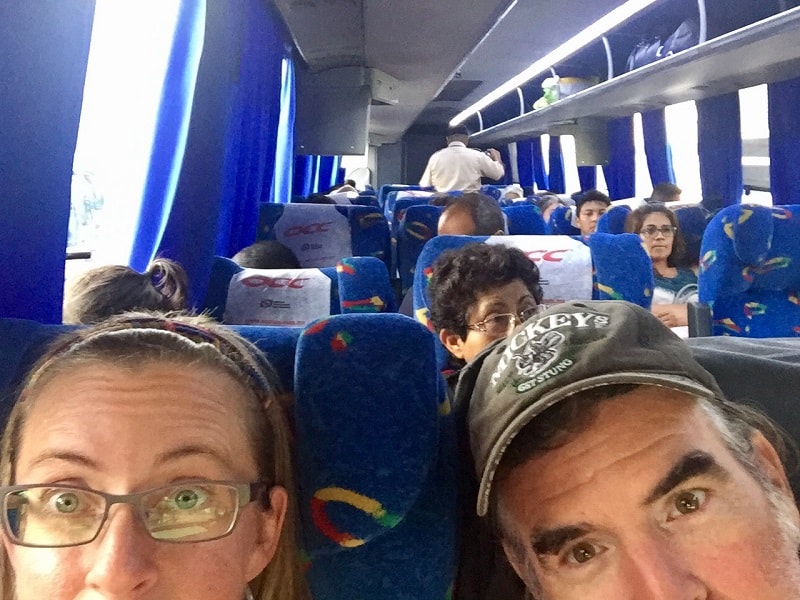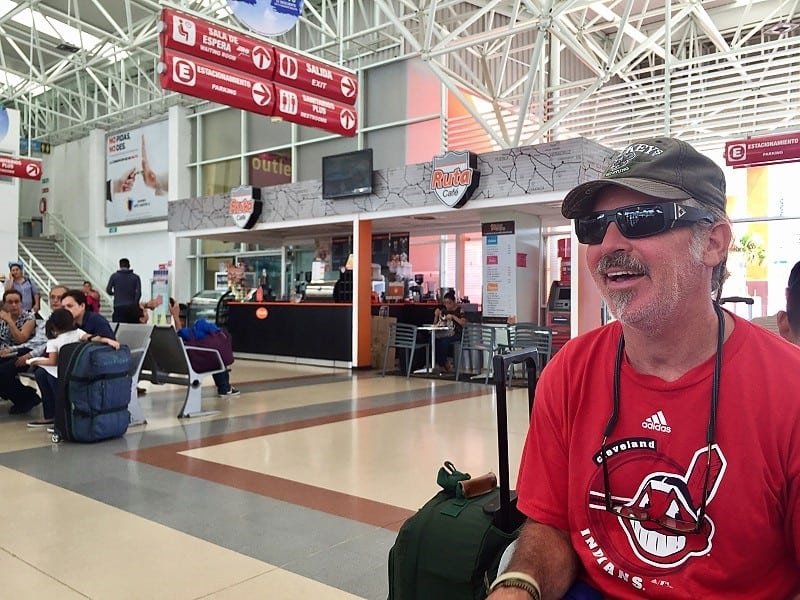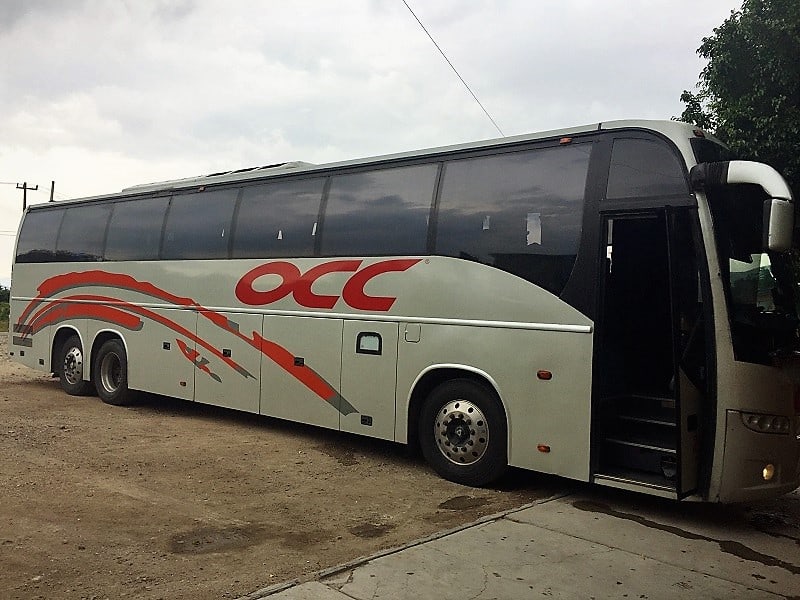Last Updated on June 3, 2023 by Ellen
As far as buses go in Mexico for long distance travel, we like ADO. It doesn’t have wifi like Tica buses in Central America, but ADO service is affordable and reliable. This last time we used the service, something new happened: more immigration officers examined passengers, and for the first time, it appeared officers took a young woman into custody.
I have no idea why that young lady was removed. Was she a migrant? A criminal? I didn’t get a great look at her, but from what I did see, she looked scared. She appeared to be of Latin descent.
The migrant problem is one that Mexico has been working on. The pace of people coming north through Mexico to try to get to the United States has been written about extensively in media over the last several years. With the current U.S. administration, people are still trying to go north – although sometimes they simply stop in Mexico, because they feel Mexico is a better-than-nothing alternative to wherever they’ve come from: Honduras, El Salvador, Venezuela, Jamaica, and beyond.
Usually, at main ADO bus stations, a security guard or ADO official will get on the bus and walk down the aisle and ask people to remove sunglasses and hats, so they can see your face for their recorded video. They pause on each person’s face as they walk down the aisle. The guard will make an announcement that it’s for passenger safety – but everyone knows they are looking for any suspects, or suspected migrants.
Here is a shot of a bus company employee taking video as he walked down the aisle.

Sometimes immigration officers will stop the bus in between stations and take video of passengers. The first time I noticed immigration officers board an ADO bus to check passengers was when we went from Chetumal to Campeche last year. Then it happened on our trip from Puerto Escondido to Tapachula, and it happened on this most recent trip, from San Cristobal to Oaxaca City. On this most recent trip, they took that young woman off the bus, and she never got back on.
About half way through our trip, immigration officers waved the driver off the road on the side of the highway. Officers got on, went directly to a man and the young woman who sat several rows behind us. They all got off the bus after some kind of short question and answer period. (I couldn’t hear.) The man came back on eventually, but the woman did not.
A few miles down the road, other immigration officers waved down the bus. This time, two officers got on and simply went to the man, presumably to ask questions about his seat mate. They left, and the bus continued on without any further incident.
Whatever the story is with that young lady, I have thought of her a few times since that bus ride, and I do hope she is okay.
Here are other facts and tips about the bus ride to Oaxaca. The bus itself was marked OCC, and that’s a line that’s owned by ADO, so I use the two names interchangeably. It is a large touring bus. OCC buses and ADO buses are in the same station. Most people just call it the ADO station. (Second class buses often have separate stations.)


The highway was extremely curvy in the mountains, and it was not possible for me to sleep because the bus heavily swayed side to side. Other times the road was nearly straight in a valley, but the roadway was often narrow with practically no shoulder.
Some American drivers used to driving in the city might think countryside bus drivers in Mexico are nuts. All kinds of passing happens on blind curves; passing two or more vehicles at a time; other maneuvers city drivers may not feel comfortable with.
Let me assure you: I’m a back seat driver if there ever was one because I cannot stand to not be in control. But, I’ve accepted that these bus drivers go the same routes daily, and they know what they’re doing. I can relax most of the time, and enjoy the ride. Also, drivers in Mexico are not as risky as some drivers in other places. In Guatemala for example, it’s common to come upon a vehicle going 25 miles per hour on a highway – at night – with no lights. Sometimes that vehicle is a semi truck.
All of that said, here is a short video that gives you a feel for what it’s like to take an ADO bus when the bus is on a curvy road, a narrow road, and when the driver makes a pass – in this case, a car and a truck at once (I was too slow to get the full car pass – I was dreaming out the window).
https://www.youtube.com/watch?v=0qCOsaLfI-Q?ecver=2
As you can see, we like to sit in the front row, passenger side. There’s also a huge picture window to the right. Sometimes the curtains don’t want to stay in place and you have to get creative and have patience. My work around this trip was clothes pins. (I carry a few because I often have to hand wash undies and gym clothes in between laundry service visits.)
You never know what you will see on the road. I saw sick cows, a disturbed man wandering in the center of the road (the bus driver alerted oncoming traffic with some kind of hand signal), every kind of conveyance you can imagine – from tuk tuks to pick up trucks carrying two dozen people and then some.
We passed the largest wind farm I’ve ever seen. It went for miles and miles. If I had to guess, it was about 20 miles – on either side of the highway – as far as you could see. I looked up info about these huge areas with wind turbines, and it turns out people who live near the wind farms say they haven’t benefited as they thought they would. So similar to how it is in the U.S. To be sure, the farms create energy for the masses, but at a cost to the people who live in the shadows of the turbines.
But, I digress.
Buy your bus tickets as early as you can. You can pick your seat, and usually the price is lower if you buy in advance. We bought our tickets a week in advance. Even just a few days is enough. Our tickets cost $25.50 each, but keep in mind, ADO is a first-class bus line – you can easily save money on second-class bus. We like the cushy seats and (relatively) decent bathrooms at most of the bus stops.
People will try to sell bus passengers snacks and drinks at stops – to passengers who don’t get off the bus. The sellers get on the bus and head down the aisle, announcing what they’ve got. Usually some kind of drink from a jug, or bags of chips or a tamale or some kind of sugary pastry.
The bus plays movies. We didn’t watch any, but you can hear the audio even if you don’t sit under the screen. The driver plays his own music. So – if you sit in the front like we do – it’s possible you’ll hear dueling audio sources for 10 hours.
You can’t control who sits behind you, and sometimes that might be a child who is restless and likes to kick your seat. Patience… patience… patience… in my case – the little girl fell asleep (somehow) and was only seated behind me for a few stops.
At one point on the trip, after sunset, the driver had to pull over and adjust a headlight. He was out there banging on it with something. A few people came over to assist him in whatever town or village we were in. Luckily, that’s all it needed – a few good whacks and we were back on the road after a 15 minute stop.
This trip was 10 hours long, even though it’s only roughly 370 miles from San Cristobal to Oaxaca City. Remember, it’s a curvy and narrow highway. Also, the bus makes stops every hour or two hours – except for the end of the trip. The bus did not stop the last three hours before we arrived in Oaxaca City. There is a bathroom on the bus for emergencies, but don’t count on that because the last three hours are extra, extra curvy and it’s not easy for us lady squatters.
You would miss all this kind of fun if you flew from Chiapas to Oaxaca. There is an airport in Tuxtla, which is about a 45-minute to 90-minute drive from San Cristobal, depending on if you’re in a car, taxi, or bus. You could fly from Tuxtla to Oaxaca City in just over one hour, but you’re going to pay a lot more than $25.50.
The next stop to explore: Oaxaca City.
🙂
*Update, 8/17/17: A friend had a few questions about more specifics on the trip, so here is additional practical information.
When you buy tickets, the clerk usually does not know English, so go prepared with some key Spanish phrases if you do not speak Spanish.
It will be obvious which stop is your if you are paying attention. Big cities are easy – like Oaxaca, Puerto Vallarta, Campeche, etc. If you are going to a small town, it may not be as obvious when the bus stops because the smaller stations are not always clearly marked with signs you can see from your seat. Simply ask the driver where you are. Drivers have itineraries and they know how many people will get off and on at each stop. That said, they aren’t baby sitters, so if you are sleeping and he pulls away, that’s your tough luck.
Also, you do not have to show any ID when you buy tickets, but as foreigners, you are expected to present your passport to any law enforcement official who asks, as I understand it, so be sure to carry it with you on long bus trips in Mexico, or any country.
🙂

Is there any way to get a bus to Oaxaca city from SanCris that has wifi? Or even has charging outllets?
Hi Gary,
I don’t have the answer. If I needed that, I would go to the bus station and ask at the counters. There could be different companies with different offers.
I do know in other parts of the world (not Mexico) WiFi is sometimes advertised as a selling point, but then the system can only handle a couple of devices at a time.
Let me know how it works out.
Best wishes and happy travels!